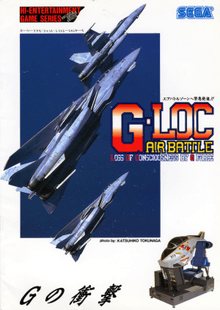G-LOC: Air Battle
| G-LOC: Air Battle | |
|---|---|
 Japanese arcade flyer featuring the sit-down unit (bottom right). | |
| Developer(s) | Sega AM2 |
| Publisher(s) | Sega |
| Designer(s) | Yu Suzuki |
| Composer(s) | Hiroshi Kawaguchi (Arcade) Matt Furniss (Mega Drive) |
| Platform(s) | Arcade, Sega Mega Drive/Genesis Sega Game Gear, Sega Master System |
| Release date(s) | Arcade 1990 Mega DriveGame Gear |
| Genre(s) | Arcade, Combat flight simulator |
| Mode(s) | Single-player |
| Cabinet | Upright Sit-down and Custom (R-360) |
| Arcade system | Sega Y-Board |
| Display | Raster resolution 320 x 224 (horizontal) Palette colors: 24576 |
G-LOC: Air Battle is a 1990 air combat arcade game by Sega. The title refers to "G-force induced Loss Of Consciousness".
Overview
The game puts the player in a fighter plane, dog fighting other planes. Once the player takes too many hits or the game-timer runs out the game is over. The player earns more time and advances stages by achieving goals that are set each stage. The player initially starts with limited armament which is replenished by completing missions.
Players choose what targets to destroy, like ships, jet fighters, or tanks. Eventually, players will attack bosses such as War Balloon, the Bomber, and the final adversary, an enemy ace who uses the same plane as the player, except with enhanced durability and strength.
Description
The player controls an experimental aircraft (referred as A8M5 which upgraded over time, and finally, the A8M6) in a mission to eliminate enemy planes. During the game the player is attacked from the front and back. The game is played most of the time in a first person perspective, however once locked by an enemy missile the perspective changes to third person behind the player's plane to allow the player to perform evasive maneuvers. The plane is controlled by joystick and has two weapons: a cannon and missiles. The player can either try to gun enemy planes down or target them by moving the crosshair over them and launch missiles at targeted planes to destroy them.
The game was released in three arcade cabinet versions, a standard standup version, a sit-down version and a deluxe-sitdown version: the R-360 cabinet. The R-360 gives the game into a more dynamic feel as the cabinet responds to the pilots actions somewhat removing the limited path the plane could move in the standup and sit-down versions.
Legacy
The game was essentially a sequel to After Burner and After Burner II although not advertised as such. This game was followed by Strike Fighter, a similar game to G-LOC which was also released in Mega-CD as After Burner III. Namco's "Operation Katina" gamemode in Ace Combat 5 features similar gameplay.
Ports
| Reception | ||||||||||||||||||||||||||||||||||||||||||||||||||||||||||||
|---|---|---|---|---|---|---|---|---|---|---|---|---|---|---|---|---|---|---|---|---|---|---|---|---|---|---|---|---|---|---|---|---|---|---|---|---|---|---|---|---|---|---|---|---|---|---|---|---|---|---|---|---|---|---|---|---|---|---|---|---|
| ||||||||||||||||||||||||||||||||||||||||||||||||||||||||||||
The game was ported to the Sega Mega Drive, the Sega Master System and the Sega Game Gear. Because the R-360 cabinet made the game more impressive the home computer versions (Commodore 64, Amstrad CPC, ZX Spectrum and Amiga) were named G-LOC R360.
Some ports include certain features not present in the arcade version. The Mega Drive version alternates between first and third-person perspectives at times, the Master System one features bosses, and the Game Gear one employs points that can be used to upgrade the jet.
References
External links
| |||||